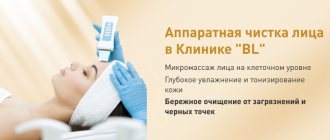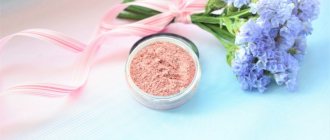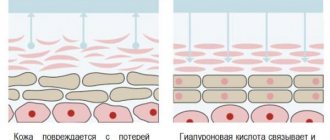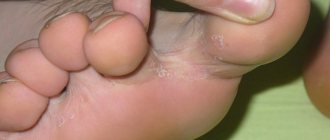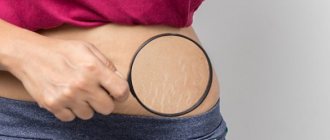What does diaper rash look like in babies?
Experts distinguish three degrees of diaper rash in newborns.
1st degree.
The initial stage of diaper rash in children is characterized by slight redness. Such diaper rash most often occurs in the folds of the skin. Usually the child will not pay attention to this minor discomfort, but parents should take the symptoms very seriously. As a rule, getting rid of diaper rash in newborns at the first stage is quite simple, but if you miss the moment, it will be more difficult later.
2nd degree.
At the next stage, the baby develops severe diaper rash - its color becomes more intense, and damage to the surface layer of the skin (erosion) appears. Diaper rash of the second degree causes anxiety in the baby. He may reach out with his hands and react nervously when touching sore areas, for example, when changing a diaper. This stage already requires special means, but before treating diaper rash in infants, parents should definitely consult a doctor.
3rd degree.
Bright redness, intense erosion, wet cracks in the skin, ulcers and small ulcers - this is what diaper rash looks like in a newborn at the most serious stage. The child feels constant itching, and this affects his behavior. The baby's sleep and appetite worsen, he is often capricious and cries. Such severe diaper rash in a newborn requires immediate consultation with a doctor and starting treatment as quickly as possible.
We hope our description helped you understand. But if you wish, you can find diaper rash in girls and boys in photos on the Internet and see what this disease looks like at different stages.
Features of the structure of the skin of a newborn
When a baby is first born, it is covered with natural lubricants that protect it from the external environment. Nowadays it is customary to let it soak in rather than wash it off immediately. But the very features of the baby’s skin can worry parents, although there is no reason for concern:
- it may be red, with clearly visible vessels. This is normal: young children have a very thin subcutaneous fat layer, because of this the blood vessels are visible through the skin, in addition, the content of red blood cells in the newborn’s blood is increased;
- some may develop small white spots. These are sebaceous cysts, they are harmless and will go away on their own when the body adapts a little;
- baby fluff, lanugo, makes baby's skin especially velvety. This is a natural cover and does not need to be removed;
- There are cases when, 2-3 days after birth, the baby’s skin begins to peel off, dry out and turn red. This is the result of adaptation to a new environment and does not indicate illness.
Why do diaper rash occur in children?
To understand how to get rid of diaper rash, you first need to understand why it occurs. Indeed, at the first stage, it is often enough to simply remove the irritants so that the baby’s diaper rash disappears.
Moisture
Moisture is the main cause of diaper rash in a newborn. In an effort to protect their baby from colds, parents often overheat the room or wrap the baby too tightly, causing the baby to sweat. Diaper rash from sweat in newborns primarily appears in the armpits, skin folds and other places of increased sweating.
Regular water procedures wash away body secretions and a significant amount of bacteria from the skin. However, what helps with diaper rash in newborns can also cause it. Water remaining on the skin after bathing is another source of excess moisture. To prevent it from getting under clothes, it is recommended to dry the baby thoroughly and let his body breathe for 10–15 minutes before dressing.
And, of course, diaper rash in newborns can appear from moisture from diapers. Pay attention to your baby's signals and carry out hygiene procedures in a timely manner. Remember: diapers can reduce the risk of diaper rash on the bottom of newborns, but only if they are changed regularly.
Friction
Diaper rash can occur due to mechanical stress on the skin. To prevent this from happening, do not swaddle your baby too tightly, do not put tight clothes on him, and avoid synthetic fabrics. Due to friction, diaper rash can also appear under the diaper belt of a newborn. This usually happens if the belt is too tight, or diapers of dubious quality were purchased.
Chemical irritants
Another reason why a newborn baby may develop diaper rash is the baby's sensitivity to certain chemicals. They can get on the skin from clothes, diapers, and cosmetics. What helps against “chemical” diaper rash in newborns? The answer is simple: buy products for your child only from manufacturers in which you are 100% confident.
Other factors
There are a number of factors that can increase the risk of this disease - excess weight, a tendency to allergies, the location of blood vessels close to the surface of the skin. There is also a gender dependence: diaper rash occurs more often in newborn girls than in boys.
Oil
Oils are often used to care for baby’s skin: they moisturize and nourish it, and promote wound healing. Vaseline oil or various types of vegetable oils (olive, fir, sea buckthorn) are suitable for children. The oils are boiled for 15 minutes in a water bath, then cooled to room temperature and applied to the skin11. Vaseline oil is considered hypoallergenic; allergic reactions to vegetable oils are possible12.
Oils are recommended to be applied to dry skin. If it is inflamed or liquid (exudate) forms on its surface, then the oil can slow down healing - a fatty film that delays air exchange will prevent the discharge from evaporating. It is undesirable to use oils for infectious complications, since microbes and fungi under the oil layer multiply even more actively. But the oil is good for moisturizing dry skin and helps restore it faster13.
Where do diaper rashes usually form? Under a diaper?
Problems usually appear in the folds of the skin, i.e. in places where moisture evaporation is difficult. The most comfortable place for diaper rash in a newborn is between the legs - in the groin area and between the buttocks, under the armpits. Also, diaper rash in a baby can form on the neck and between the toes.
As you can see, this disease manifests itself not only on the butt in a diaper. It can pop up unexpectedly anywhere. Diaper rash can even occur behind the ears, especially in newborns whose parents wear hats that are too thick and tight.
Treatment
In the initial stage of the disease, it is enough to remove the causes of its appearance. It is necessary to frequently and thoroughly wash all folds of the skin with warm water, a pink solution of potassium permanganate, and special antiseptic agents. After washing, be sure to thoroughly blot with a cotton cloth until completely dry, powder with talcum powder or use baby cream, zinc ointment, or any drying creams and ointments. It is necessary to ensure free access of air to the sore areas; if necessary, gauze pads can be attached to them. For moderate severity of diaper rash, lotions and compresses are effective. Therapeutic baths based on medicinal herbs are very helpful in the fight against diaper rash. In addition to the purely therapeutic effect, they provide an opportunity to rest and relax, and have a beneficial effect on the human body as a whole.
Are prickly heat and diaper rash in newborns the same thing?
No, these are different diseases. Diaper rash in newborns occurs due to various reasons, and prickly heat, as the name suggests, is only caused by excessive sweating. At the initial stage, prickly heat manifests itself in a similar way - as slight redness of the skin, but then develops into small blisters with clear or cloudy contents.
For a better understanding, find a photo of prickly heat and, for example, diaper rash on a newborn’s bottom - as you will see, they look completely different.
The good news is that there is no need to treat heat rash, you just need to eliminate its causes - overheating of the baby and clogged pores. Traditional methods of preventing diaper rash in newborns, including maintaining the correct temperature in the room, water and air baths, usually eliminate miliaria.
Folk remedies14
There are numerous traditional medicine recipes for the treatment and prevention of diaper rash:
- Infusion of bay leaves, decoctions of oak bark, string, chamomile are used for rubbing and compresses for diaper rash, and added to bathing water. They increase the protective properties of the skin and fight inflammation. The plants can be brewed separately or mixed together.
- Instead of powders, traditional medicine recommends potato, corn starch or sifted flour (preferably buckwheat). Unlike cosmetics, they definitely do not contain any additives - neither harmful nor beneficial.
- There is an opinion that you can dry the skin using tooth powder: it is diluted with water to a paste, applied to the inflamed area of the skin, left for 15-20 minutes, then washed off with a decoction of string or oak bark.
- Birch buds are crushed and mixed with petroleum jelly and used to treat diaper rash.
- It is recommended to apply plantain or fern juice fresh to inflamed skin.
In folk medicine, there are recipes with alcohol tinctures or honey - it is better to refrain from using them so as not to get a burn on the baby’s delicate skin. It is important to understand that home remedies have not been clinically tested, so their effectiveness and safety have not been studied. For example, herbs are positioned as natural and harmless, but they can cause severe allergic reactions if individual intolerance occurs. Therefore, before entrusting your child’s health to traditional medicine, it is better to consult a pediatrician.
How to avoid diaper rash?
Many diseases are easier to prevent than to cure, and diaper rash in a newborn is no exception. What to do to protect your baby from this scourge? Nothing complicated!
- Avoid situations where your child sweats:
- Monitor the temperature in the room. It is advisable that the thermometer does not rise above 18–20 degrees. This will significantly increase the chances of both avoiding diaper rash and protecting the baby from prickly heat.
- Refuse synthetics in favor of natural fabrics (cotton, linen).
- Try not to wrap your baby up.
- Minimize the risk of friction:
- Do not put tight clothes on your child.
- Avoid rough fabrics.
- Follow the rules of hygiene:
- Bathe your baby daily.
- Treat skin folds with protective cream or baby oil. Pay special attention to problem areas - under the arms, on the neck, in the groin, between the buttocks.
- After bathing, dry your baby's body with a towel, but do not rub him. In addition to regular textile towels, you can also use paper towels.
- To avoid diaper rash, use only products from reputable manufacturers.
- Change diapers regularly and do not forget about the benefits of air baths lasting about 10-15 minutes.
Prevention
In order not to encounter the problem of treating diaper rash, special attention should be paid to the baby’s hygiene, which is the best protective remedy against inflammation. Doctors also advise:
Doctors also advise:
- regular air baths for the child;
- bathing the baby in water with potassium permanganate;
- using safe detergents when washing baby’s clothes;
- regular diaper changes;
- use diapers only during long walks.
You should not be too zealous in using various creams, as the body may simply wean itself from using its protective functions. The paste or medicated ointment should be used after consultation with an experienced physician. In any case, it is the application of simple hygiene rules that will prevent the baby from getting sick.




